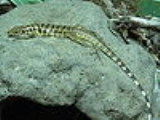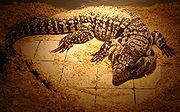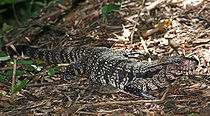
Tupinambis
Encyclopedia
Tupinambis is a lizard
genus which belongs to the family Teiidae
, and contains seven described species. These large, South America
n lizards are commonly referred to as tegus; Tupinambis merianae (Argentine Black and White Tegu
), Tupinambis rufescens (Red Tegu), and Tupinambis teguixin (Colombian Black and White Tegu, Gold Tegu, or Common Tegu) are all common in the pet trade. Tegus that have escaped or have been illegally released have adapted to life in the wild in some of the more remote areas of South Florida.
Tegus are usually primarily carnivorous, except for T. rufescens (which is primarily herbivorous) and T. merianae (which changes from a mostly carnivorous diet as a juvenile, to a mostly herbivorous diet as an adult). Tegus fill the same ecological niche as monitor lizard
s and are an example of convergent evolution
.
 The two most docile and easiest to handle species are the Argentine Black and White Tegu and the Red Tegu. Additionally, a new variety has been recently introduced, called the Blue tegu
The two most docile and easiest to handle species are the Argentine Black and White Tegu and the Red Tegu. Additionally, a new variety has been recently introduced, called the Blue tegu
due to the tendency of males to become bright blue upon maturity. These variations grow from just under 2 feet to a larger 4+ feet (gold and blue tegus being the smallest and the red and Argentine black and white being the largest) and have a pleasant nature, making them popular pets. Tegus are also recognized for their intelligence, and have an impressive ability to remember details.
Most tegus are opportunistic feeders, accepting a wide variety of foods. Tegus' diets can consist of cricket
s, mealworm
s, an occasional mouse, fish
, hard boiled eggs, chicken, etc. Certain fruits and vegetables may be offered as well (for example, strawberries, mango
es, papaya
s, banana
s) but usually will only be eaten by the red or Argentinian black and white tegus. The Colombian tegus tend to be almost entirely carnivore
s/insectivores.
Dairy products should never be given to reptiles, since, like all other non-mammalian creatures, they lack the ability to digest lactose
(only mammals can).
Also, dog food should only be offered in strict moderation to thin, underdeveloped, or sick animals, and only for a limited time. Dog food contains many ingredients that are not meant for lizard consumption, and is also very fatty. In addition, all tegus need size-appropriate housing with UVA and UVB light setups, maintaining a steady enclosure temperature of 80 F–90 F during the day and at about 75F during the night.
Because tegus, like all lizards, are ectothermic, a temperature gradient will allow them to find the perfect location for their needs, so they also need a spot for basking with a temperature of 100F-110F. This can mean that a variable number of "warm spots" are needed in a housing; so the animal can comfortably move between them, as often as necessary, the number depending mostly on the local climate.
cycle. It has been discovered that this is not needed to maintain their health, but it may have adverse effects on sexual development if their first years' hibernation is skipped.

Lizard
Lizards are a widespread group of squamate reptiles, with nearly 3800 species, ranging across all continents except Antarctica as well as most oceanic island chains...
genus which belongs to the family Teiidae
Teiidae
Teiidae is a family of lizards native to the Americas, generally known as whiptails. The group includes the parthenogenic genera Cnemidophorus and Aspidoscelis, and the non-parthenogenic Tupinambis. It has over 230 member species in ten genera...
, and contains seven described species. These large, South America
South America
South America is a continent situated in the Western Hemisphere, mostly in the Southern Hemisphere, with a relatively small portion in the Northern Hemisphere. The continent is also considered a subcontinent of the Americas. It is bordered on the west by the Pacific Ocean and on the north and east...
n lizards are commonly referred to as tegus; Tupinambis merianae (Argentine Black and White Tegu
Argentine Black and White Tegu
The Argentine black and white tegu, , is the largest species of tegu. It is also known as the Argentine giant tegu. It belongs to the teiid family...
), Tupinambis rufescens (Red Tegu), and Tupinambis teguixin (Colombian Black and White Tegu, Gold Tegu, or Common Tegu) are all common in the pet trade. Tegus that have escaped or have been illegally released have adapted to life in the wild in some of the more remote areas of South Florida.
Tegus are usually primarily carnivorous, except for T. rufescens (which is primarily herbivorous) and T. merianae (which changes from a mostly carnivorous diet as a juvenile, to a mostly herbivorous diet as an adult). Tegus fill the same ecological niche as monitor lizard
Monitor lizard
Monitor lizards are usually large reptiles, although some can be as small as in length. They have long necks, powerful tails and claws, and well-developed limbs. Most species are terrestrial, but arboreal and semiaquatic monitors are also known...
s and are an example of convergent evolution
Convergent evolution
Convergent evolution describes the acquisition of the same biological trait in unrelated lineages.The wing is a classic example of convergent evolution in action. Although their last common ancestor did not have wings, both birds and bats do, and are capable of powered flight. The wings are...
.
In captivity

Blue Tegu
The blue tegu is a smaller tegu, growing to about 1 meter long, renowned for its light blue coloration, which is most intense on adult males. Even immature animals can be easily distinguished from other mostly black and white tegu species by the "singe mark" on their nose...
due to the tendency of males to become bright blue upon maturity. These variations grow from just under 2 feet to a larger 4+ feet (gold and blue tegus being the smallest and the red and Argentine black and white being the largest) and have a pleasant nature, making them popular pets. Tegus are also recognized for their intelligence, and have an impressive ability to remember details.
Most tegus are opportunistic feeders, accepting a wide variety of foods. Tegus' diets can consist of cricket
Cricket
Cricket is a bat-and-ball game played between two teams of 11 players on an oval-shaped field, at the centre of which is a rectangular 22-yard long pitch. One team bats, trying to score as many runs as possible while the other team bowls and fields, trying to dismiss the batsmen and thus limit the...
s, mealworm
Mealworm
Mealworms are the larval form of the mealworm beetle, Tenebrio molitor, a species of darkling beetle. Like all holometabolic insects, they go through four life stages: egg, larva, pupa, and adult...
s, an occasional mouse, fish
Fish
Fish are a paraphyletic group of organisms that consist of all gill-bearing aquatic vertebrate animals that lack limbs with digits. Included in this definition are the living hagfish, lampreys, and cartilaginous and bony fish, as well as various extinct related groups...
, hard boiled eggs, chicken, etc. Certain fruits and vegetables may be offered as well (for example, strawberries, mango
Mango
The mango is a fleshy stone fruit belonging to the genus Mangifera, consisting of numerous tropical fruiting trees in the flowering plant family Anacardiaceae. The mango is native to India from where it spread all over the world. It is also the most cultivated fruit of the tropical world. While...
es, papaya
Papaya
The papaya , papaw, or pawpaw is the fruit of the plant Carica papaya, the sole species in the genus Carica of the plant family Caricaceae...
s, banana
Banana
Banana is the common name for herbaceous plants of the genus Musa and for the fruit they produce. Bananas come in a variety of sizes and colors when ripe, including yellow, purple, and red....
s) but usually will only be eaten by the red or Argentinian black and white tegus. The Colombian tegus tend to be almost entirely carnivore
Carnivore
A carnivore meaning 'meat eater' is an organism that derives its energy and nutrient requirements from a diet consisting mainly or exclusively of animal tissue, whether through predation or scavenging...
s/insectivores.
Dairy products should never be given to reptiles, since, like all other non-mammalian creatures, they lack the ability to digest lactose
Lactose
Lactose is a disaccharide sugar that is found most notably in milk and is formed from galactose and glucose. Lactose makes up around 2~8% of milk , although the amount varies among species and individuals. It is extracted from sweet or sour whey. The name comes from or , the Latin word for milk,...
(only mammals can).
Also, dog food should only be offered in strict moderation to thin, underdeveloped, or sick animals, and only for a limited time. Dog food contains many ingredients that are not meant for lizard consumption, and is also very fatty. In addition, all tegus need size-appropriate housing with UVA and UVB light setups, maintaining a steady enclosure temperature of 80 F–90 F during the day and at about 75F during the night.
Because tegus, like all lizards, are ectothermic, a temperature gradient will allow them to find the perfect location for their needs, so they also need a spot for basking with a temperature of 100F-110F. This can mean that a variable number of "warm spots" are needed in a housing; so the animal can comfortably move between them, as often as necessary, the number depending mostly on the local climate.
Hibernation
Tegus naturally go into a hibernationHibernation
Hibernation is a state of inactivity and metabolic depression in animals, characterized by lower body temperature, slower breathing, and lower metabolic rate. Hibernating animals conserve food, especially during winter when food supplies are limited, tapping energy reserves, body fat, at a slow rate...
cycle. It has been discovered that this is not needed to maintain their health, but it may have adverse effects on sexual development if their first years' hibernation is skipped.
Species

- Tupinambis duseni – Yellow Tegu - Lönnberg 1896
- Tupinambis longilineus – Rondônia Tegu
- Tupinambis merianae – Argentine Black and White TeguArgentine Black and White TeguThe Argentine black and white tegu, , is the largest species of tegu. It is also known as the Argentine giant tegu. It belongs to the teiid family...
(formerly T. teguixin) - Tupinambis quadrilineatus – Four-striped Tegu
- Tupinambis palustris - Manzani & Abe 2002
- Tupinambis rufescens – Red Tegu - Günther 1871
- Tupinambis teguixin – Gold TeguGold teguThe gold tegu, also known as common tegu, black tegu and Colombian tegu, is a species of tegu. Its old scientific name was Tupinambis nigropunctatus but it has since renamed to Tupinambis teguixin....
(formerly T. nigropunctatus)

